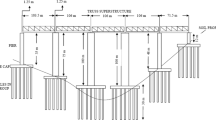Abstract
Recently, the fully integral bridge system that integrates the entire superstructures and substructures together to form a monolithic rigid frame has been presented, since it is anticipated that this approach will lead to improvements in aesthetics, economic efficiency, and seismic performance of a bridge system. This study is related to a fully integral steel bridge with struts installed in-between the piers at the middle of the bridge span, which is called a strut-braced pier. Thus, it is expected that the strut-braced pier mainly prevents horizontal loads like earthquake load or vehicle braking load. In this study, the seismic performance of the fully integral steel bridge was evaluated in accordance with Caltrans Seismic Design Criteria which involves displacement criteria, displacement ductility capacity requirement, and member force criteria. The capacities of the member forces and the displacement were determined through nonlinear static pushover analysis using OpenSees. As a result, the fully integral steel bridge met the seismic performance criteria specified in Caltrans with a great margin. A parametric study was conducted to investigate the effect of strut stiffness on the seismic capacities and effects from the horizontal load of the fully integral steel bridge. The results show that the displacement capacity and displacement ductility capacity of the fully integral steel bridge have a slight change when the strut stiffness increases. The member force capacity is primarily affected by the strut-braced pier and increases significantly along with the strut stiffness. The lateral displacement and the sectional member forces are well controlled to a converging value by a proper application of the strut stiffness. Therefore, it was found that the minimum stiffness required for the struts can be defined to sufficiently resist design seismic loads, and thus, the sectional properties of all intermediate piers can be reasonably adjusted by varying only the stiffness of the struts connected to the braced piers. It has a great significance in that such results lead to the feasibility of various economical designs of bridge substructure including piers suitable for each situation.







Similar content being viewed by others
References
American Association of State Highway and Transportation Officials (AASHTO). (2020). AASHTO Load and resistance factor design (LRFD) specifications. D. C., USA.
Attarchian, N., Kalantari, A., and Moghaddam, A. S. (2014). Cyclic behavior modeling of rectangular rc bridge pies using opensees. 4th International Conference on Computational Methods in Structural Dynamics and Earthquake Engineering, 2286–2295.
Caltrans (2013). Caltrans seismic design criteria, version 1.6. California Department of Transportation.
Choi, B. H., Kwak, J. Y., Kim, T. G., & Lim, C. S. (2018). Load distribution characteristics and construction stage analysis of a fully integral railroad bridge with end-restraining abutment. Journal of the Korean Society of Civil Engineers, 18(2), 261–270.
Choi, B. H., Moreno, L. B., Lim, C. S., Nguyen, D. D., and Lee, T. H. (2019). Seismic performance evaluation of a fully integral concrete bridge with end-restraining abutments. Advances in Civil Engineering, 1–12.
Erhan, S., & Dicleli, M. (2014). Comparative assessment of the seismic performance of integral and conventional bridges with respect to the differences at the abutments. Bulletin of Earthquake Engineering, 13(2), 653–677.
Far, N. E., Maleki, S., & Barghian, M. (2015). Design of integral abutment bridges for combined thermal and seismic loads. Earthquake and Structures, 9(2), 415–430.
Faraji, S., Ting, J. M., Crovo, D. S., & Ernst, H. (2001). Nonlinear analysis of integral bridges: Finite-element model. Journal of Geotechnical and Geoenvironmental Engineering, ASCE, 127(5), 454–461.
Greimann, L. F., Yang, P., & Wolde-Tinsae, A. M. (1986). Nonlinear analysis of integral abutment bridges. Journal of Structural Engineering, ASCE, 112(10), 2263–2280.
Kent, D. C., & Park, R. (1971). Flexural members with confined concrete. ASCE Journal of the Structural Division, 97(7), 1969–1990.
Korean Construction Standards Center (KDS 24 17 11) (2018). Guidelines for the Bridge Seismic Design Standard (LSD).
Kozak, D. L., LaFave, J. M., & Fahnestock, L. A. (2014). Seismic modeling of integral abutment bridges in Illinois. Engineering Structures, 165(15), 170–183.
Lee, T. H., & Nguyen, D. D. (2018). Seismic vulnerability assessment of a continuous steel box girder bridge considering influence of LRB properties. Sadhana, 43(1), 14.
Mander, J. B., Priestley, M. J. N., & Park, R. (1988). Theoretical stress–strain model for confined concrete. Journal of Structural Engineering, ASCE, 114(8), 1804–1826.
Mazzoni, S., McKenna, F., Scott, M. H., & Fenves, G. L. (2007). OpenSees command language manual. University of California Berkeley USA.
Menegotto, M., & Pinto, P. E. (1973). Method of analysis for cyclically loaded reinforced concrete plane frames including changes in geometry and non-elastic behavior of elements under combined normal force and bending. IABSE Symposium of Resistance and Ultimate Deformability of Structures Acted on by Well-Defined Repeated Loads, Lisbon, Portugal, 13, 15–22.
Paraschos, A. and Amde, A. M. (2011). A survey on the status of use, problems, and costs associated with Integral Abutment Bridges. Better Roads, 1–20.
Priestly, M. J. N., Seible, F., & Calvi, G. M. (1996). Seismic design and retrofit of bridges (pp. 265–456). Wiley.
White, H. (2007). Integral abutment bridges: Comparison of current practice between European countries and the united states of America. New York State Department of Transportation. New York, NY, USA.
Acknowledgements
This research was supported by the research fund of Hanbat National University in 2019.
Author information
Authors and Affiliations
Corresponding author
Ethics declarations
Conflict of interest
Authors declare that no conflicts of interest.
Additional information
Publisher's Note
Springer Nature remains neutral with regard to jurisdictional claims in published maps and institutional affiliations.
Rights and permissions
Springer Nature or its licensor (e.g. a society or other partner) holds exclusive rights to this article under a publishing agreement with the author(s) or other rightsholder(s); author self-archiving of the accepted manuscript version of this article is solely governed by the terms of such publishing agreement and applicable law.
About this article
Cite this article
Choi, B.H., Kwak, J. & Diep, H.T. Effect of Strut Stiffness on Seismic Performance of Fully Integral Steel Bridge with a Strut-Braced Pier. Int J Steel Struct 24, 366–376 (2024). https://doi.org/10.1007/s13296-024-00821-y
Received:
Accepted:
Published:
Issue Date:
DOI: https://doi.org/10.1007/s13296-024-00821-y



